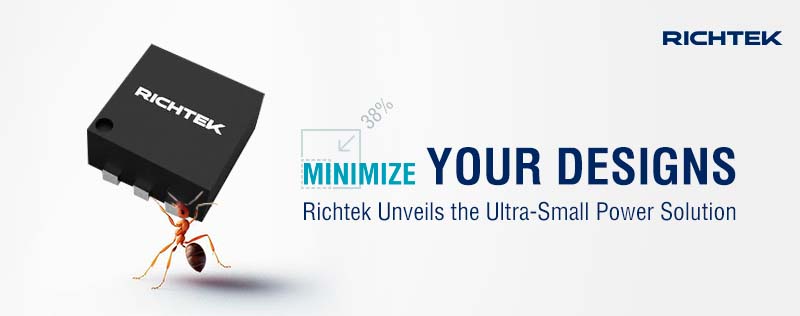| |
| Minimize Your Designs:Richtek Unveils the Ultra-Small Power Solution |
|
|
| |
 |
| |
 |
Ultra-Small Chip Size |
|
|
Richtek continues to innovate power solutions for compact applications with the introduction of the RT5716, a low-input-voltage synchronous buck converter, available in an ultra-small 1.04x0.69mm² WCSP package. With 4MHz switching frequency, the RT5716 has an overall circuit design of only 4.65mm², saving 38% of PCB layout area compared to the previous generation of Richtek's products. |
| |
 |
Excellent Transient Response |
|
|
The RT5716 is based on the Ripple-Based COT (RBCOT) topology, featuring enhanced load transient response, with only 41% of the voltage variation compared to our previous generation products. For example, with a loading range of 0.05A to 0.8A and ramp time of 1µs, the Vpp is only 93mV. |
| |
 |
Ultra-Compact Applications |
|
|
The RT5716 effectively reduces PCB layout area and enhances load transient response. It has been selected by major companies in Europe and the U.S. and is widely applied in handheld devices, asset trackers, battery-powered equipment, wearables, retimers, IoT devices, and medical equipment (such as hearing aids). |
| |
|
|
| |
|
|
|
2.3µA Iq, 0.6A/1A Iout, 1.8V to 5.5Vin RBCOT Buck Converter in TWL-CSP-6B 0.69x1.04 (BSC) and WDFN-6L 1.5x1.5 (FC) packages.
|
 |
 |
|
|
| |
|
|
| |
|
|
|
360nA low Iq, 0.4A Iout, 2.2V to 5.5Vin HCOT Buck converter in WL-CSP-6B 1.415x0.885 (BSC) and WDFN-6L 2x2 packages.
|
 |
 |
|
|
| |
|
|
|
360nA low Iq, 0.6A lout, 2.2V to 5.5Vin HCOT Buck converter in WL-CSP-6B 1.415x0.885 (BSC) and WDFN-6L 2x2 packages.
|
 |
 |
|
|
| |
|
|
|
Incorporating the fast load transient response of our patented HCOT topology and aiming for even faster response, we have introduced the latest Ripple-Based COT (RBCOT) control. This method injects output voltage ripple variations into the control loop, enabling real-time detection of voltage drops and adjusting the duty cycle accordingly. The conduction time can vary based on load current until the output voltage reaches its rated value, providing superior voltage compensation compared to the HCOT topology.
|
|
| |
|
|
|
Want to keep up to date with all our latest news and information? Subscribe here.
|










